Published
on 2
Aug 2007
|
All rights reserved.
|
|
|
 Looking back to the evolution
of
Maserati's GT car, I am grateful to see it gets into better and better
shape. A dozen years ago the loss-making Italian company was still
making Shamal, a strange-looking and poorly built coupe from the De
Tomaso era. As Fiat bought the firm and put it under the management of
Ferrari, a new car called 3200GT was launched in 1998. It still
employed the Shamal's twin-turbo V8, but a much better looking Giugiaro
design and modern chassis started changing the fate of Maserati.
Through the years build quality and reliability gradually improved to
more acceptable level. A new Ferrari-developed V8 entered the scene in
2001 and changed its name to 4200GT. Then came its derivative Spyder
and GranSport. By the second quarter of 2007, Maserati finally earned
its first ever profit since it went under the wing of Fiat. Improved
products, servicing and sales network bring more and more satisfying
customers to the once notorious Italian brand. The Quattroporte is
doing well on the sales chart, especially since it added an automatic
transmission. Now to sustain the growth, Maserati is going to count
very much on the new GranTurismo. Looking back to the evolution
of
Maserati's GT car, I am grateful to see it gets into better and better
shape. A dozen years ago the loss-making Italian company was still
making Shamal, a strange-looking and poorly built coupe from the De
Tomaso era. As Fiat bought the firm and put it under the management of
Ferrari, a new car called 3200GT was launched in 1998. It still
employed the Shamal's twin-turbo V8, but a much better looking Giugiaro
design and modern chassis started changing the fate of Maserati.
Through the years build quality and reliability gradually improved to
more acceptable level. A new Ferrari-developed V8 entered the scene in
2001 and changed its name to 4200GT. Then came its derivative Spyder
and GranSport. By the second quarter of 2007, Maserati finally earned
its first ever profit since it went under the wing of Fiat. Improved
products, servicing and sales network bring more and more satisfying
customers to the once notorious Italian brand. The Quattroporte is
doing well on the sales chart, especially since it added an automatic
transmission. Now to sustain the growth, Maserati is going to count
very much on the new GranTurismo.
Apparently,
GranTursimo is the successor to 4200GT and GranSport, as it
becomes the new entry-level Maserati. However, the company officials
said it is a very different car. Now under the management of Alfa
Romeo, Maserati is turning away from the role as "junior Ferrari".
Instead, it will become more luxurious oriented, offering more comfort
and refinement, higher quality and less fuss to drive. In other words,
it will compete head-on with Jaguar XKR and Mercedes CL500 (all on sale
at £70,000-80,000). This sounds a little sad, but I do believe it
will help getting more business to the Modena factory.
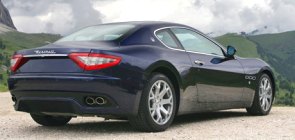 Going mainstream does not mean
losing its own character. The GT can
still distinguish from other rivals by its Italian design. Styled by
Pininfarina - possibly with the help of Frank Stephenson, it has some
beautiful curves, flowing lines and perfect proportion to deliver an
extremely sexy and emotional appeal. Let's call it the Marilyn Monroe
of cars, albeit a Marilyn Monroe with a big mouth – the big convex
grille is a classic feature copied from the 1953 Maserati A6GCS. It
cleverly links the new Maserati to the past legend and contributes to
higher perceived value. The GranTursimo is one of the best looking GTs
in the world, unquestionably. Only Aston Martin DB9 and Bentley
Continental GT can rival its beauty, yet all three have different
personalities. Going mainstream does not mean
losing its own character. The GT can
still distinguish from other rivals by its Italian design. Styled by
Pininfarina - possibly with the help of Frank Stephenson, it has some
beautiful curves, flowing lines and perfect proportion to deliver an
extremely sexy and emotional appeal. Let's call it the Marilyn Monroe
of cars, albeit a Marilyn Monroe with a big mouth – the big convex
grille is a classic feature copied from the 1953 Maserati A6GCS. It
cleverly links the new Maserati to the past legend and contributes to
higher perceived value. The GranTursimo is one of the best looking GTs
in the world, unquestionably. Only Aston Martin DB9 and Bentley
Continental GT can rival its beauty, yet all three have different
personalities.
As expected
for an
Italian luxury car, the interior of GranTurismo is richly trimmed with
leather. What really surprised is the build quality and the amount of
space available. High quality plastic and assembly finally landed on the Italian car,
as is a good satellite navigation and audio system which came from PSA.
The dashboard may be a little short on style (admittedly, we have
higher expectation for an Italian car in this respect), but the sense
of quality and solidity matches German machines and leaves nothing to
be desired. Moreover, the pronounced flanks viewed from the driver seat
remind you this is something more exotic than the German cars. Rear
seat accommodation is generous, enough for most adults traveling for
long distance with reasonable comfort. Among its rivals, only Mercedes
CL can do the same.
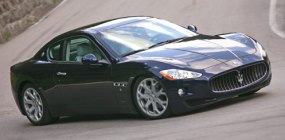
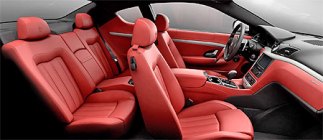 In
fact, the weight distribution could have been made even more
rear-biased should it adopt Maserati's Cambiocorsa transaxle, but the
recent experience of Quattroporte tell us that the majority of
customers prefer the smooth-shifting ZF automatic transmission than the
jerky Cambiocorsa, so the GT adopted the front-mounted automatic
transmission from the saloon and offers no manual transmission for
choose. Keen drivers must be unhappy. In
fact, the weight distribution could have been made even more
rear-biased should it adopt Maserati's Cambiocorsa transaxle, but the
recent experience of Quattroporte tell us that the majority of
customers prefer the smooth-shifting ZF automatic transmission than the
jerky Cambiocorsa, so the GT adopted the front-mounted automatic
transmission from the saloon and offers no manual transmission for
choose. Keen drivers must be unhappy.
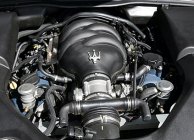 What
remains unchanged from the old car is the 4244cc Ferrari V8 with intake
variable valve timing. Output figures raised slightly to 405 hp / 7100
rpm and 339 lbft / 4750 rpm, but its rev-hungry character keeps intact.
It used to be a magnificent engine in the old car, but in the heavier
GranTurismo and mates with power-consuming torque converter, its lack
of mid-range torque is even more obvious. Maserati claims it goes from
0-60 mph in 5.0 seconds, but my experience tell me never to have too
much faith in Maserati's figures. On the road, the GT feels much slower
than the supercharged Jaguar XKR. Even Mercedes CL500 has more
accessible performance. In fact, it feels more like in the league of
the naturally aspirated Jaguar XK, which has only 300hp on tap. What
remains unchanged from the old car is the 4244cc Ferrari V8 with intake
variable valve timing. Output figures raised slightly to 405 hp / 7100
rpm and 339 lbft / 4750 rpm, but its rev-hungry character keeps intact.
It used to be a magnificent engine in the old car, but in the heavier
GranTurismo and mates with power-consuming torque converter, its lack
of mid-range torque is even more obvious. Maserati claims it goes from
0-60 mph in 5.0 seconds, but my experience tell me never to have too
much faith in Maserati's figures. On the road, the GT feels much slower
than the supercharged Jaguar XKR. Even Mercedes CL500 has more
accessible performance. In fact, it feels more like in the league of
the naturally aspirated Jaguar XK, which has only 300hp on tap.
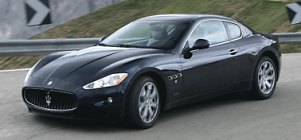 The GT
performs best as a long distance tourer. Unlike GranSport, its
suspensions are tuned to be relatively soft. This results in more body
roll but the ride is comfortable even without ticking the optional
Skyhook adaptive dampers. The strong chassis and noise insulation
provides good refinement – when did you last time hear the word
"refinement" associated with Maserati's coupe ? Wind noise, tire noise
and suspensions noise are limited, leaving only the melodic roar from
the high-revving V8 entering the cabin. The shift program of the ZF
transmission is not as perfect as in Jaguar XK (for example, not as
responsive and no throttle blip during downshifts), but it still shifts
smoothly most of the time. The GranTurismo may surprise many people by
its high level of polishing. The GT
performs best as a long distance tourer. Unlike GranSport, its
suspensions are tuned to be relatively soft. This results in more body
roll but the ride is comfortable even without ticking the optional
Skyhook adaptive dampers. The strong chassis and noise insulation
provides good refinement – when did you last time hear the word
"refinement" associated with Maserati's coupe ? Wind noise, tire noise
and suspensions noise are limited, leaving only the melodic roar from
the high-revving V8 entering the cabin. The shift program of the ZF
transmission is not as perfect as in Jaguar XK (for example, not as
responsive and no throttle blip during downshifts), but it still shifts
smoothly most of the time. The GranTurismo may surprise many people by
its high level of polishing.
Enter
a corner, you can feel the well balanced chassis steers keenly into the
bend. The perfectly weighted steering wheel transmits abundance of
information to your hands. The tires generate bags of grip. The Brembo
brakes seems to lack initial bite, but press the pedal harder and it
becomes instantly powerful. So far so good.
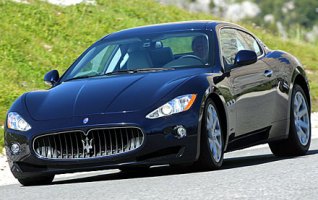 Push it above 80 percent effort, however, its obedient
handling gives
way to understeer and body roll. It feels softer than Jaguar XKR and
even the larger Quattroporte Sport GT reported last year felt more
agile under pressure. As the GranTurismo is derived from the shortened
Quattroporte platform, its handling could only be better. Undoubtedly,
its civilized manner is down to softer suspension tuning. Push it above 80 percent effort, however, its obedient
handling gives
way to understeer and body roll. It feels softer than Jaguar XKR and
even the larger Quattroporte Sport GT reported last year felt more
agile under pressure. As the GranTurismo is derived from the shortened
Quattroporte platform, its handling could only be better. Undoubtedly,
its civilized manner is down to softer suspension tuning.
That doesn't matter. Sooner or later Maserati will introduce a sport
version of the GT, just like Quattroporte Sport GT and the outgoing
GranSport. With a fundamental so good, a firmer suspension will
undoubtedly convert the GranTurismo into a great driver's car. I am
really optimistic about that. The lack of performance can also be
rectified in the near future. A 450-horsepower, 4.7-liter version of
the V8 is already in the engine bay of Alfa Romeo 8C Competizione, so
there is no reason why it can't be used in the Maserati.
Before that happens, the Maserati is still hugely desirable for looks,
cabin
space, ride quality, refinement and sense of occasion. However, in pure
driving terms, Jaguar XKR is the better car. |
Verdict:     |
| Published on 22
May
2008 |
All rights reserved.
|
|
GranTurismo S
|
|
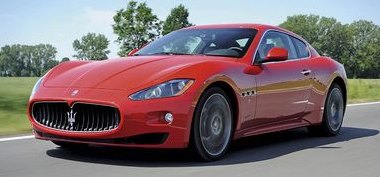 The S does not feel as powerful as BMW
M6 or Mercedes CL63, but its exhaust noise is certainly more exciting...
The S does not feel as powerful as BMW
M6 or Mercedes CL63, but its exhaust noise is certainly more exciting...
To
silence those criticizing the standard GranTurismo gone soft, Maserati
has produced a hotter version called GranTurismo S. Externally, it can
be barely distinguished from the regular car by a set of new alloy
wheels (with more stylish design and 1 inch larger diameter), lower
profile tires, more pronounced side skirts, a tiny boot lid spoiler and
oval exhausts.
However, these minor tweaks make a sexy design even more attractive.
What you cannot see from outside are plenty. First of all, open the
bonnet and you will find a 4.7-liter version of the previous 4.2-liter
V8, basically the same as that serving Alfa Romeo 8C Competizione. It
produces 440 horsepower at 7000 rpm, 35 ponies up from the old engine,
and 361 lb-ft of torque instead of 339 lb-ft. This is achieved by
enlarging the bore by 2mm and lengthening the stroke by 4.7mm. Slightly
disappointing though, it has yet to receive direct injection, unlike
Lamborghini’s new V10 and Ferrari California’s V8. We expect the new
engine will go to the regular GranTurismo as well as Quattroporte
saloon soon.
Thankfully, the new engine has not changed its character much. It
remains smooth, highly responsive to throttle and very eager to rev.
Don’t expect it to produce a lot more bottom end torque. In fact, its
torque curve is closely matched with the old engine’s, just runs higher
values from 2000 rpm to 7000-plus rpm. This allows 0-60 mph to be cut
by three-tenths to 4.7 seconds and lift its top speed to 183 mph. The
GranTurismo S does not feel as mind-blowing powerful as BMW M6 or
Mercedes CL63 AMG, but its exhaust noise is certainly more exciting,
especially when you press the Sport mode button to open its by-pass
valves in exhaust silencers.
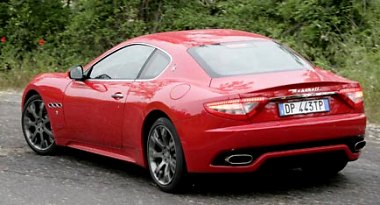 If you can see it as a "4-seat sports
car", everything suddenly makes sense...
If you can see it as a "4-seat sports
car", everything suddenly makes sense...
However,
the biggest change to S is not the new engine but the transmission. The
standard GranTurismo disappointed us somewhat by switching to a
front-mounted automatic transmission. Now GranTurismo S brings back
Maserati’s renowned semi-automatic transaxle. By placing the 6-speed
automated manual gearbox at the other end of the car and connect it to
the engine through a rigid torque tube, Maserati changed its weight
distribution from the previous 49:51 to 47:53, a figure I would
consider as more desirable for a rear-drive machine. No wonder the S
displays better traction and quicker turn-in through corners.
The automated manual gearbox works very well in manual mode. Gearshifts
are made cleanly and instantaneously (as short as 100ms) through
steering wheel paddles. This let the driver feels more connected to the
engine thus more satisfying to drive. In automatic mode the gearshift
is reasonably refined, but sometimes jerky and never matches a real
automatic transmission for smoothness. This problem probably won’t be
solved until Maserati develops a dual-clutch gearbox.
The S has 10 percent stiffer suspensions to improve its body control
and agility. Moreover, braking is upgraded to Brembo’s new dual-cast
brake discs – each consists of an aluminum core laminated with cast
iron surfaces to reduce weight and provide better heat dissipation -
and 6-piston calipers. As a result, the car is more capable in bends.
Although it can’t overwhelm German machines for cornering prowess or
braking, its neutral and agile handling, marvelous engine and addictive
noise are more than capable to make it the most entertaining 4-seater
GT this side of Ferrari 612.
Being a real Maserati, this car won’t be perfect, of course. Its most
obvious flaws are the transmission roughness and a harsh ride. Both are
acceptable to keen drivers, but they prevent this car from becoming a
great long-distance grand tourer. However, if you can see it as a "4-seat sports car", everything
suddenly makes sense. Yes, let the German to make cruisers. Italian
always makes the best sports cars. |
Verdict:     |
| Published
on 19
Feb
2010 |
All rights reserved.
|
|
GranCabrio
|
|
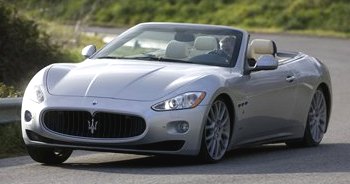 Maserati's new cabriolet is flawed but
lovely
Maserati's new cabriolet is flawed but
lovely
I
wonder why it took Maserati two and a half years to produce the
cabriolet version of GranTurismo. Anyway, like waiting for a beautiful
girl in your very first date, the wait is worthwhile. We are not
talking about its competence. GranCabrio is not that fast compared with
German and British GT cars. Its naturally-aspirated 4.7-liter V8 and
automatic transmission struggles to crack 60 mph in 5.2 seconds while
rivals can effortlessly do sub-5. Its 2-ton weight (100 kg more than
GranTurismo) is always in your mind. It's not as refined as Jaguar XKR
convertible, Bentley Continental GTC or Mercedes SL63 either. Although
the chassis strengthening is adequate, its firm-setting Skyhook
suspension struggles on poor surfaces, transmitting quite a lot of
harshness and noise into the cabin. Regarding practicality, its
spacious cabin is largely offset by a tiny boot measuring just 173
liters, limiting its usage as a long-distance tourer.
What makes the open-top Maserati so appealing is its character, style
and sound in particular. This is easily the sexiest convertible on the
planet. With the roof chopped, it looks even sleeker and sexier than
the GranTurismo. Its fabric roof is stored neatly under cover, and the upper
edge of cabin is nicely decorated with chromed lining. Not even an
Aston Martin DB9 Volante can match its beauty.
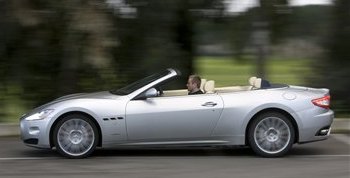 This is the only convertible luxurious
grand tourer capable of seating 4 adults
This is the only convertible luxurious
grand tourer capable of seating 4 adults
The Ferrari-built V8 might be underpowered
(or more precisely, undertorqued) to haul the heavyweight machine, but
it still produces the best vocal among rivals. That sound, together
with the sexy look and the Italian leather smell lifts your emotion,
reminding you a great car is more than the summation of its mechanical
parts. Once you are in love with it, all the aforementioned flaws
become forgivable. Turn into the first corner, you will find another
thing it is so different from rivals. Despite of its weight and long
wheelbase, it feels really agile. Perhaps not as agile as the lighter
and stiffer coupe, but it still steers more sweetly and eagerly than
other grand tourer convertibles.
Character aside, the main selling point of GranCabrio is its 4-seater
cabin. Its rear seats are repositioned slightly inward, forward and
upward compared with the coupe in order to leave space for the roof
mechanism, pop-up protection bars and underfloor reinforcement. Still,
it is a true 4-seater, capable of seating four six-footers. Although
rear headroom is reduced to 5 ft 8 in or so with the roof up, the
4-seat accommodation it offers is still unique in the luxurious GT
class, at least until Mercedes E-class convertible arrived. However,
the latter is neither a GT nor a rival to the Maserati. Its rivals like
Aston DB9 Volante, Bentley Continental GTC, Jaguar XKR convertible, BMW
6-series convertible, Mercedes SL and Ferrari California are all either
2+2 or 2-seater. If you want a convertible luxurious grand tourer
capable of accommodating four people, Maserati GranCabrio will be the
only choice - a flawed but lovely choice. |
Verdict:     |
| Published
on 3
Mar
2011 |
All rights reserved.
|
|
GranTurismo MC Stradale
|
|
No other car makers are more fond of silly names than
Maserati. Take a look to its price list and you will find model names
such as "Four Doors" (Quattroporte), GT (GranTurismo) and Big Cabriolet
(GranCabrio). Even stranger is this one – MC Stradale. Its full name
should be GranTurismo Maserati Corsa Stradale, or in English "Grand
Tourer Maserati Race Street". So what is it ? A high-speed GT ? A race
car ? or a street car ? These identities seem to be contradicting with
each other. However, take a ride on the car and you will stop laughing.
Yes, the new Maserati is all of them. Really.
Gorgeous, sexy and graceful, the MC Stradale is just as beautiful as
other variants of GranTurismo. Simultaneously, the aero package from MC
Trofeo race car injected a greater sense of sportiness. Ditto the
effect of lower ride height (by 10 mm front and 12 mm rear), thin-spoke
alloy wheels and the two vents on the bonnet.
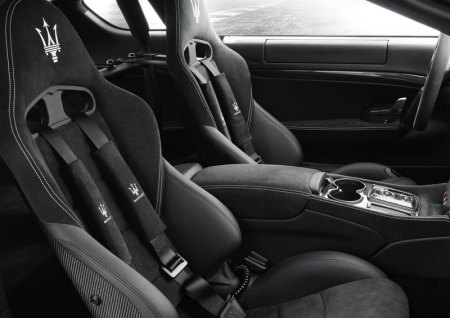
Open the doors, you will see a race-car-inspired interior. Most
surfaces are trimmed with Alcantara instead of leather, while
carbon-fiber inserts are added for obvious reasons. The front bucket
seats become lightweight carbon-fiber items. The rear seats are even
discarded. They save 26kg and 16kg respectively. Taking the space of
rear seats is now a roll cage, which on the one hand reinforces the
whole structure for better handling, on the other hand serves as the
attachment point of the racing harnesses. This is the racing side of
its character.
Further weight saving comes from reduced sound deadening, lightweight
wheels, standard ceramic brakes and the use of robotized manual gearbox
instead of the standard car's ZF automatic. As a result, MC Stradale is
110 kg lighter than the standard GranTurismo.
But then you may realize that it still weighs some 1770 kg, so it is
hardly a lightweight special. Moreover, the 4.7-liter V8 has received
the lightest modifications – an ECU tweak, a more efficient lubrication
system and application of low-friction diamond-like coating on tappets
and cam lobes – so it produces only 10 more horsepower and 15 lbft more
torque than the standard engine. Performance is marginally improved to
187 mph and 0-60 mph in 4.4 seconds. Not too spectacular these days.
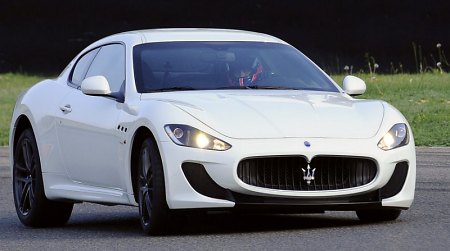
However, on the road the MC Stradale can feel far more exotic than
those numbers suggested. Switch on the "Race" mode, the exhaust note
becomes thunderous as the magnificent V8 screams towards 7500 rpm
redline. It also turns the robotized gearbox into madness – each
gearshift takes only 60 milliseconds, matching Ferrari Scuderia and 599
GTO, and it is accompanied with a momentary shockwave to raise your
pulse. This marvelous powertrain reminds us that speed is nothing
without drama. The Italian still knows how to engage drivers better
than everyone else.
A similar story can be told for its handling. Look at the photos, you
can see the MC Stradale rolls a touch more than most German performance
machines in corners. Never mind. What counts is the agility it displays
in the twisty. With a perfect weight distribution of 48 percent front
and 52 percent rear, the Maserati is easily more agile than anything
else this size and weight. It is better balanced, more adjustable and
more transparent to the driver. It won't outhandle a Porsche 911, but
that is only down to its extra size and weight. Compare with other
versions of GranTurismo, the MC Stradale handles better, thanks to its
lower ride height, stiffer suspensions and specially developed Pirelli
P-Zeros.
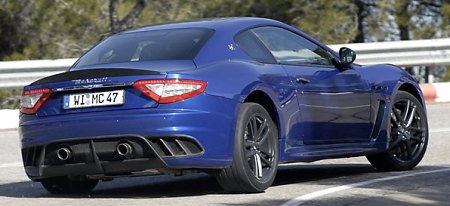
However, what really surprises is how civilized the car behaves when
you are not in a hurry. In Auto mode, the gearshift is smooth and the
engine is just as quiet as the regular GranTurismo. Sport mode speeds
up the manual gearshift and throttle response, but it leaves the
exhaust bypass valve closed until you hit 4000 rpm, so the level of
refinement goes in sync with your driving mood. The V8 is always smooth
and tractable, with at least 80 percent of its max torque available
from 2500 rpm upward. The ride is also surprisingly supple, actually as
good as the regular GranTurismo, although there is more road noise
generated from the P-Zeros. MC Stradale did not opt for the Skyhook
adaptive dampers but a set of stiffer passive dampers for their more
consistent response. Its springs are 8 percent stiffer than those on
GranTurismo S, while front and rear anti-roll bars are thicker. Despite
these, it still rides very well on road. Thanks must go to those
ceramic brake discs, which save 14 kg from unsprung weight.
No wonder it is Corsa and Stradale simultaneously.
Being a 2-seater, the MC Stradale may be pitched
against thoroughbred sports cars like Porsche
911 GT3 RS and Aston Martin V12 Vantage. To beat them
in dynamics is hopeless, of course. However, if all you want is a
car combining GT comfort (albeit for two), sexy appeal and occasional
race car thrills, nothing would be better than the MC Stradale. It's
that unique. |
Verdict:      |
| Published
on 1
Jun
2012 |
All rights reserved.
|
|
GranTurismo Sport
|
|
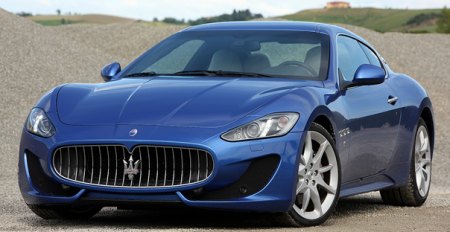
This is yet another small
update by Maserati. The GranTurismo Sport replaces the 4-year-old
GranTurismo S to be the core model of its family. It slots between the
entry-level 4.2-liter model and the striped-out MC Stradale. As before,
its key rivals include Jaguar XKR, BMW 6-series, Mercedes CL-class and
the slightly pricier Bentley Continental GT.
You can't see any radical changes in the update, but all revisions
point to the right direction. The front-end styling is benefited from
MC Stradale and looks sexier than ever. Inside, there are some tweaks
to the trims and a pair of new front seats that not only offers more
lateral support but also frees up rear knee room by 20 mm. Under the
bonnet, the Ferrari-built 4.7-liter V8 is a further improvement from
that of the MC. It gets not only the low-friction treatment but also
revised pistons, valve timing and ECU mapping, yielding another 10
horsepower and 7 pound-foot of torque – by the way, the MC will get the
same engine later this year. That is a reasonable pump of 20 hp and 22
lbft from the car it replaces. On the road, the extra punch is not
very obvious until the top end of its spectrum. Instead, you will be
aware
of the improvement made to the ZF 6-speed automatic transmission. Its
new software leads to quicker yet smooth gearchanges. Shift time is
halved from 400 to 200 ms in the fastest mode. Furthermore, it has
learnt how to blip throttle to match rev during downshift, so to
smoothen the transition. Now the automatic is so good that you can
forget the automated manual transaxle, whose hardcore manner suits MC
Stradale more.
The transaxle does bring better weight distribution and sharper
turn-in, but the auto is not bad either, with 51 percent of its weight
acting upon the rear axle. Moreover, the Sport gets stiffer suspension
setting than the S, with the Skyhook dampers set 10 percent stiffer at
Sport mode and a 12 percent stiffer rear anti-roll bar. This sharpens
its handling and makes the car feel smaller than it has any right to
be. Meanwhile, lighter brakes cut unsprung weight and maintain a
composed ride.
The update has ironed out some flaws of the old car, especially the
gearbox. It makes the GranTurismo more desirable than ever. Although it
is not as quick or as luxurious as rivals, the Maserati is
unquestionably the most charismatic. Therefore it is our first
choice of the class.
|
Verdict:     |
|